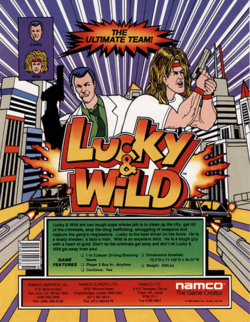Lucky & Wild
| Lucky & Wild | |
|---|---|
|
Arcade flyer | |
| Developer(s) | Namco |
| Publisher(s) | Namco |
| Designer(s) |
Taro Okamoto (designer)[1] S. Tohyama (designer)[1] Y. Kounoe (designer)[1] |
| Composer(s) | Etsuo Ishii[1] |
| Platform(s) | Arcade |
| Release date(s) |
|
| Genre(s) | First-person racing/shooter |
| Mode(s) | 2 players can play simultaneously (official) |
| Cabinet | Upright and cockpit |
| Arcade system | Namco System 2 |
| CPU |
2x Motorola 68000 @ 12.288 MHz, 1x Motorola M6809 @ 3.072 MHz, 1x Hitachi HD63705 @ 2.048 MHz |
| Sound |
1x Yamaha YM2151 @ 3.57958 MHz, 1x C140 @ 21.39 kHz |
| Display | Horizontal orientation, Raster, 288 x 224 resolution |
Lucky & Wild (ラッキー&ワイルド Rakkī & Wairudo) is a 1st-person racing/shooter arcade game that was released by Namco in 1992; it ran on Namco System 2 hardware,[2] and was the sixth game from them that featured the Federal Bureau of Investigation's "Winners Don't Use Drugs" screen in its attract mode. The game's plot (and setting) resembled the 1989 American action/comedy film of Tango & Cash, as well as Starsky and Hutch.
Gameplay
The first player's character, "Lucky", a sophisticated man in a business suit, modeled after "Starsky" and "Tango", has to both drive by means of a steering wheel and accelerator pedal, and shoot by means of a lightgun; however, the second player's character, "Wild", a surfer with long blond hair, modeled after "Hutch" and "Cash", just has to shoot by means of a second lightgun. The game is like a cross between all three Final Laps (1987–92), with both Steel Gunners (1990–91) - and the players must help Lucky & Wild catch six wanted suspects ("Jerky", "Gambit", who looks like Bebop from Teenage Mutant Ninja Turtles prior to mutation, "Juliora", "Keel", "Bear", and "Big Cigar" himself). As they pursue the suspect for every stage, they must fire at other enemy cars (with "Big Cigar"'s henchmen in them) - and they must destroy the henchmen as well as the cars, along with any projectiles fired at them, and obstacles that block them. When they catch up with the suspect, they must continuously fire upon their car until its energy is depleted; if they succeed in doing so, they will have captured the suspect and will receive a reward, but if the stage's timer runs out, the suspect will escape (indicated by the text of "GOT AWAY" appearing on the screen). After each stage, Lucky and Wild shall drive onto the "Pink Cats Garage" (which sounds like it is run by the Meowky gang from 1983's Mappy) to get their car repaired for the next stage, where they will be "entertained" by young women wearing cats' tails and ears - and the game ends when all six stages are cleared, regardless of how many suspects have been captured. There are also five different ways to play the game: one player driving and shooting and one player driving and shooting with another player shooting (official), but also one player driving with another player manning the gun, one player driving with another player manning both guns, and one player driving, another player manning one gun and a third player manning the second gun (unofficial), for Namco never manufactured a game that allowed a maximum of three players to play simultaneously.
References in other games
Lucky & Wild is also borrowed as a fictional American tuning car company brand in the Ridge Racer games with products being muscle cars (similar to those of Danver); the formation of Lucky & Wild protagonists later appeared in Mario Kart Arcade GP DX, with one player driving and the second serving as the gunner. Also, in the first episode of the interactive video series Bear Stearns Bravo, Bear Stearns CEO Jackie Dalton refers to the regulators Franco and Henri by the names "Lucky & Wild".
References
- 1 2 3 4 "lucky & wild, video game at arcade-history". arcade-history.com. Retrieved 2008-07-31.
- ↑ Prosser, Paul. "Arcade-History.".
External links
- Lucky & Wild at the Killer List of Videogames
- Lucky & Wild at the Arcade History database
